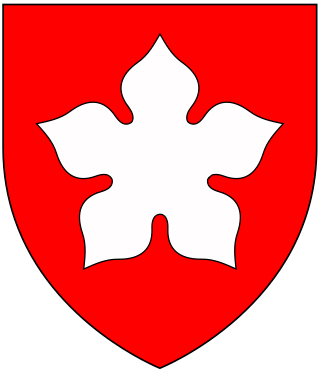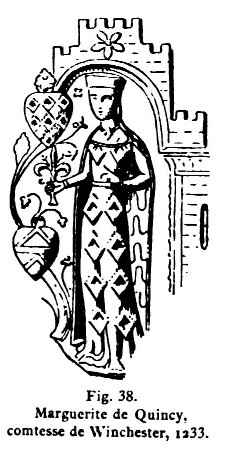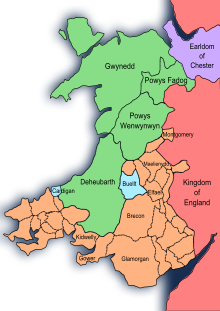
Magna Carta Libertatum, commonly called Magna Carta or sometimes Magna Charta, is a royal charter of rights agreed to by King John of England at Runnymede, near Windsor, on 15 June 1215. First drafted by the Archbishop of Canterbury, Cardinal Stephen Langton, to make peace between the unpopular king and a group of rebel barons, it promised the protection of church rights, protection for the barons from illegal imprisonment, access to swift and impartial justice, and limitations on feudal payments to the Crown, to be implemented through a council of 25 barons. Neither side stood by their commitments, and the charter was annulled by Pope Innocent III, leading to the First Barons' War.

The Earldom of Chester was one of the most powerful earldoms in medieval England, extending principally over the counties of Cheshire and Flintshire. Since 1301 the title has generally been granted to heirs apparent to the English throne, and after 1707 the British throne. From the late 14th century, it has been given only in conjunction with that of Prince of Wales.

Saer de Quincy, 1st Earl of Winchester was one of the leaders of the baronial rebellion against John, King of England, and a major figure in both the kingdoms of Scotland and England in the decades around the turn of the twelfth and thirteenth centuries.

The First Barons' War (1215–1217) was a civil war in the Kingdom of England in which a group of rebellious major landowners led by Robert Fitzwalter waged war against King John of England. The conflict resulted from King John's disastrous wars against King Philip II of France, which led to the collapse of the Angevin Empire, and John's subsequent refusal to accept and abide by Magna Carta, which John had sealed on 15 June 1215.

Ranulf de Blondeville, 6th Earl of Chester and 1st Earl of Lincoln, known in some references as the 4th Earl of Chester, was one of the "old school" of Anglo-Norman barons whose loyalty to the Angevin dynasty was consistent but contingent on the receipt of lucrative favours. He has been described as "almost the last relic of the great feudal aristocracy of the Conquest".

Sir Falkes de Bréauté was an Anglo-Norman soldier who earned high office by loyally serving first King John and later King Henry III in the First Barons' War. He played a key role in the Battle of Lincoln Fair in 1217. He attempted to rival Hubert de Burgh, and as a result fell from power in 1224. His "heraldic device" is now popularly said to have been a griffin, although his coat of arms as depicted by Matthew Paris in his Chronica Majora was Gules, a cinquefoil argent.

The Charter of the Forest of 1217 is a charter that re-established for free men rights of access to the royal forest that had been eroded by King William the Conqueror and his heirs. Many of its provisions were in force for centuries afterwards. It was originally sealed in England by the young King Henry III, acting under the regency of William Marshal, 1st Earl of Pembroke.
William II de Ferrers, 4th Earl of Derby, was a favourite of King John of England. He succeeded to the estate upon the death of his father, William de Ferrers, 3rd Earl of Derby, at the Siege of Acre in 1190. He was head of a family which controlled a large part of Derbyshire which included an area known as Duffield Frith.

Henry de Lacy, Earl of Lincoln, Baron of Pontefract, Lord of Bowland, Baron of Halton and hereditary Constable of Chester, was an English nobleman and confidant of King Edward I. He served Edward in Wales, France, and Scotland, both as a soldier and a diplomat. Through his mother he was a great-grandson of Amadeus IV, Count of Savoy. He is the addressee, or joint composer, of a poem by Walter of Bibbesworth about crusading, La pleinte par entre missire Henry de Lacy et sire Wauter de Bybelesworthe pur la croiserie en la terre seinte.
Events from the 1210s in England.
Ranulf le Meschin, 3rd Earl of Chester (1070–1129) was a Norman magnate based in northern and central England. Originating in Bessin in Normandy, Ranulf made his career in England thanks to his kinship with Hugh d'Avranches - the Earl of Chester, the patronage of kings William II Rufus and Henry I Beauclerc, and his marriage to Lucy, heiress of the Bolingbroke-Spalding estates in Lincolnshire.
Feudal relief was a one-off "fine" or form of taxation payable to an overlord by the heir of a feudal tenant to license him to take possession of his fief, i.e. an estate-in-land, by inheritance. It is comparable to a death duty or inheritance tax.
Hawise of Chester, 1st Countess of Lincoln suo jure, was an Anglo-Norman noblewoman and a wealthy heiress. Her father was Hugh de Kevelioc, 5th Earl of Chester. She was the sister and a co-heiress of Ranulf de Blondeville, 6th Earl of Chester. She was created suo jure 1st Countess of Lincoln in 1232. She was the wife of Robert de Quincy, by whom she had one daughter, Margaret, who became heiress to her title and estates. She was also known as Hawise of Kevelioc.

Margaret de Quincy, suo jure 2nd Countess of Lincoln was a wealthy English noblewoman and heiress having inherited in her own right the Earldom of Lincoln and honours of Bolingbroke from her mother Hawise of Chester, received a dower from the estates of her first husband, and acquired a dower third from the extensive earldom of Pembroke following the death of her second husband, Walter Marshal, 5th Earl of Pembroke. Her first husband was John de Lacy, 2nd Earl of Lincoln, by whom she had two children. He was created 2nd Earl of Lincoln by right of his marriage to Margaret. Margaret has been described as "one of the two towering female figures of the mid-13th century".

The Forests of Mara and Mondrem were adjacent medieval forests in Cheshire, England, which in the 11th century extended to over 60 square miles (160 km2), stretching from the Mersey in the north almost to Nantwich in the south, and from the Gowy in the west to the Weaver in the east. Mara and Mondrem were a hunting forest of the Norman Earls of Chester, established soon after 1071 by the first earl, Hugh d'Avranches. They might earlier have been an Anglo-Saxon hunting forest. Game included wild boar, and red, fallow and roe deer.

John de Lacy, 2nd Earl of Lincoln was hereditary Constable of Chester, 7th Baron of Pontefract, 8th Baron of Halton and 8th Lord of Bowland.

Gerbod the Fleming, of Oosterzele, 1st Earl of Chester, was a hereditary advocate of the Abbey of Saint Bertin at Saint-Omer, County of Flanders and Earl of Chester in 1070.

The Constable of Chester was a mediaeval hereditary office held by the Barons of Halton. The functions of the Constable are unclear, possibly they related to the custody of Chester Castle, as was the main function of most mediaeval constables, but Sanders (1960) says the office-holder was constable for the entire County Palatine.
Sir Edward de Warren was an illegitimate son of John de Warenne, 7th Earl of Surrey by his mistress Maud de Nerford of Norfolk. He was lord of the manor of Skeyton and also held other lands in Norfolk. His son Sir John de Warren was the first of this surname to succeed to the manors of Stockport and Poynton in Cheshire, and Woodplumpton in Lancashire.












